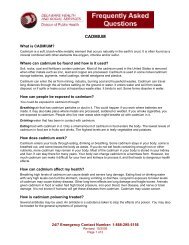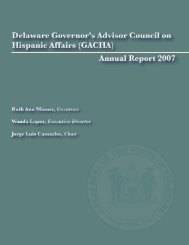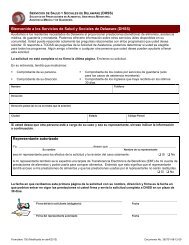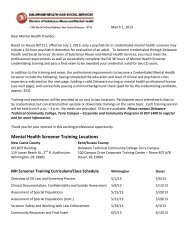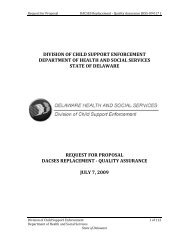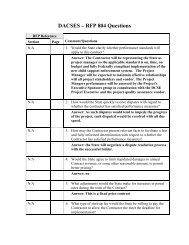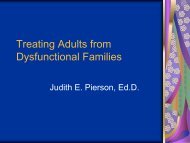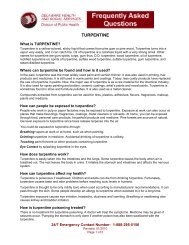Transference, Countertransference, and Vicarious Traumatization in ...
Transference, Countertransference, and Vicarious Traumatization in ...
Transference, Countertransference, and Vicarious Traumatization in ...
Create successful ePaper yourself
Turn your PDF publications into a flip-book with our unique Google optimized e-Paper software.
Treat<strong>in</strong>g Complex Trauma:<br />
Relational Heal<strong>in</strong>g for<br />
Relational Injury<br />
Christ<strong>in</strong>e A. Courtois, Ph.D.<br />
Psychologist, Independent Practice<br />
Christ<strong>in</strong>e A. Courtois, Ph.D. & Associates, PLC<br />
Wash<strong>in</strong>gton, DC<br />
202-362-2776<br />
CACourtoisPhD@aol.com
Relational Approaches to Heal<strong>in</strong>g<br />
Attachment-Based Complex Trauma<br />
nI. Introduction: Complex Trauma,<br />
CPTSD/DESNOS, <strong>and</strong> Dissociation<br />
utypes of traumatic stressors<br />
ucriteria of diagnostic conceptualizations<br />
uco-morbidity<br />
udist<strong>in</strong>ction from/resemblance to BPD<br />
u<strong>in</strong>clusion of dissociation
Relational Approaches to Heal<strong>in</strong>g<br />
Attachment-Based Complex Trauma<br />
nII. Treatment: The Cl<strong>in</strong>ical<br />
Consensus/Evidence-Based Meta-Model<br />
uThe (evolv<strong>in</strong>g) st<strong>and</strong>ard of care<br />
uPhilosophy, pr<strong>in</strong>ciples <strong>and</strong> goals of practice<br />
uGeneral structure <strong>and</strong> sequence<br />
uIntegrated, multimodal <strong>and</strong> <strong>in</strong>dividualized<br />
uAttachment/relationship issues<br />
relationship as BOTH conta<strong>in</strong>er <strong>and</strong> catalyst<br />
learn<strong>in</strong>g laboratory for other relationships<br />
“earned security” of attachment
Relational Approaches to Heal<strong>in</strong>g<br />
Attachment-Based Complex Trauma<br />
nIII. Relational Issues<br />
uThe self of the therapist<br />
uRelational approach: RICH model<br />
uTreatment relationship def<strong>in</strong>ed <strong>and</strong> delimited<br />
uBoundary issues<br />
uAttachment-based underst<strong>and</strong><strong>in</strong>g & approaches<br />
uUse of relationship to underst<strong>and</strong> the client<br />
uVT<br />
uTherapist self-care, support, & consultation
Interpersonal Trauma:<br />
“A break <strong>in</strong> the human lifel<strong>in</strong>e”<br />
Robert Lifton<br />
Self <strong>and</strong> <strong>in</strong>terpersonal effects<br />
brought to treatment
Relational Heal<strong>in</strong>g for<br />
Interpersonal Attachment<br />
(Relational) Trauma
Trauma Def<strong>in</strong>ed<br />
“... ...the unique <strong>in</strong>dividual experience, associated<br />
with an event or endur<strong>in</strong>g conditions, <strong>in</strong><br />
which the <strong>in</strong>dividual’s ability to <strong>in</strong>tegrate<br />
affective experience is overwhelmed or the<br />
<strong>in</strong>dividual experiences a threat to life or<br />
bodily <strong>in</strong>tegrity…”<br />
(Pearlman & Saakvitne, 1990)
Trauma Def<strong>in</strong>ed<br />
n“An experience of unbearable affect”<br />
(Krystal, 1978)<br />
n“The sudden uncontrollable loss of<br />
affiliative bonds.”<br />
(L<strong>in</strong>demann, 1944)
Types of Traumatic Stressors<br />
Emotional Trauma<br />
“It is the essence of emotional trauma that it<br />
shatters…absolutisms, a catastrophic loss of<br />
<strong>in</strong>nocence that permanently alters one’s<br />
sense of be<strong>in</strong>g-<strong>in</strong>-the-world.”<br />
(Heidegger, quoted <strong>in</strong> Stolorow, 2007)
Types of Traumatic Stressors<br />
nAttachment/Relational Trauma<br />
uoccurs <strong>in</strong> attachment relationships with primary<br />
caregivers<br />
<strong>in</strong>security of response <strong>and</strong> availability<br />
mis-attunement, non-response<br />
lack of car<strong>in</strong>g <strong>and</strong> reflection of self-worth<br />
caregiver as the source of both fear <strong>and</strong><br />
comfort<br />
u<strong>in</strong>cludes DV <strong>and</strong> child abuse of all types<br />
often “on top of”/<strong>in</strong> context of attachment <strong>in</strong>security<br />
neglect, ab<strong>and</strong>onment, non-protection, nonresponse,<br />
sexual <strong>and</strong> physical abuse <strong>and</strong> violence,<br />
verbal assault
Types of Traumatic Stressors<br />
nRelational trauma<br />
udisruptions <strong>in</strong> the sense of safety, security,<br />
loyalty, <strong>and</strong> trust that may block connections<br />
<strong>and</strong> communication <strong>in</strong> the family of orig<strong>in</strong> <strong>and</strong><br />
that extend to other relationships<br />
nBetrayal trauma<br />
u<strong>in</strong>volves betrayal of a role or relationship<br />
nSecond <strong>in</strong>jury<br />
u<strong>in</strong>volves lack of assistance <strong>and</strong>/or <strong>in</strong>sensitivity<br />
on the part of those who are supposed to help or<br />
<strong>in</strong>tervene
Types of Traumatic Stressors<br />
nDevelopmental Trauma<br />
u “orig<strong>in</strong>ates with<strong>in</strong> a formative <strong>in</strong>ter-subjective context<br />
whose central feature is mal-attunement to pa<strong>in</strong>ful<br />
affect--a breakdown of the child-caregiver system of<br />
mutual regulation”<br />
u It cannot be overemphasized that <strong>in</strong>jurious childhood<br />
experiences <strong>in</strong> <strong>and</strong> of themselves need not be traumatic<br />
(or at least not last<strong>in</strong>gly so) or pathogenic, provided that<br />
they occur with<strong>in</strong> a responsive milieu. Pa<strong>in</strong> is not<br />
pathology. It is the absence of adequate attunement <strong>and</strong><br />
responsiveness to the child’s pa<strong>in</strong>ful emotional reaction<br />
that renders them unendurable <strong>and</strong> thus a source of<br />
traumatic states <strong>and</strong> psychopathology.<br />
Stolorow, 2007
Types of Traumatic Stressors<br />
nComplex Trauma<br />
uAttachment/relational/developmental trauma &/or<br />
uOther forms of chronic trauma<br />
Domestic violence<br />
Community violence<br />
Combat trauma: warrior or civilian, POW<br />
Political trauma: refugee status, displacement,<br />
political persecution, “ethnic cleans<strong>in</strong>g”<br />
Slavery/forced servitude<br />
Chronic illness w/ <strong>in</strong>vasive treatment<br />
Bully<strong>in</strong>g<br />
Sexual harassment<br />
Other...
Types of Post-trauma Responses<br />
nComplex Developmental/Dissociative<br />
Trauma<br />
uAssociated with chronic, pervasive, cumulative<br />
trauma <strong>in</strong> childhood, often on a foundation of<br />
attachment/relational trauma<br />
<strong>in</strong>secure attachment, especially disorganized<br />
all forms of abuse <strong>and</strong> neglect, exposure<br />
severely impacts the develop<strong>in</strong>g child<br />
• neurophysiology<br />
• psychophysiology<br />
• bio-psycho-social maturation & development,<br />
<strong>in</strong>clud<strong>in</strong>g attachment capacity/style
Post-trauma Responses <strong>and</strong> Disorders<br />
nPeritraumatic Reactions<br />
nPosttraumatic Reactions<br />
uimmediate (may resolve, cont<strong>in</strong>ue, or return)<br />
udelayed<br />
uchronic<br />
nAcute Stress Disorder<br />
u4 weeks’ duration or less<br />
n“Simple” or Classic Posttraumatic Stress<br />
Disorder<br />
uimmediate<br />
udelayed<br />
uchronic<br />
uoften/usually co-morbid (depression, anxiety, ED/SA/<br />
OCD; Axis I, II, & III)
PTSD: Diagnostic Criteria<br />
(DSM-IV, American Psychiatric Association, 1994)<br />
n A. Exposure to a traumatic event<br />
u 1. objective seriousness (limited def<strong>in</strong>ition)<br />
u 2. subjective response: fear, horror, helplessness<br />
n B. Traumatic event is persistently re-experienced<br />
n C. Persistent avoidance of stimuli associated with<br />
the trauma<br />
n D. Persistent symptoms of <strong>in</strong>creased arousal<br />
n E. Duration of B, C, & D > 1month<br />
n F. Cl<strong>in</strong>ically significant distress or impairment
PTSD <strong>in</strong> Children<br />
nNo available childhood PTSD or DD<br />
diagnosis <strong>in</strong> the DSM<br />
nChildren respond as children, not as little<br />
adults<br />
u work of Terr, Putnam, Pynoos, Perry has been<br />
<strong>in</strong>strumental to early underst<strong>and</strong><strong>in</strong>g of childhood<br />
trauma<br />
nChildren are very vulnerable, yet resilient<br />
uon average, takes less to traumatize them
(Proposed) Developmental Trauma Disorder<br />
(van der Kolk, 2005)<br />
nDoma<strong>in</strong>s of impairment <strong>in</strong> children<br />
exposed to complex trauma:<br />
uAttachment/relationship capacity<br />
uBiology<br />
uAffect regulation<br />
uDissociation<br />
uBehavioral control<br />
uCognition<br />
uSelf-concept
The Significance of Labels<br />
“To attribute the affective chaos or schizoid<br />
withdrawal of patients who were abused as<br />
children to ‘fantasy’ or to ‘borderl<strong>in</strong>e<br />
personality organization’ is tantamount to<br />
blam<strong>in</strong>g the victim <strong>and</strong>, <strong>in</strong> do<strong>in</strong>g so,<br />
reproduces features of the orig<strong>in</strong>al trauma”.<br />
(Stolorow, 2007)
Post-trauma Responses <strong>and</strong> Disorders<br />
n Complex Posttraumatic Stress Disorder/<br />
(DESNOS) “PTSD plus”<br />
urelated to severe chronic abuse, usually <strong>in</strong><br />
childhood, <strong>and</strong> attachment disturbance<br />
uusually highly co-morbid<br />
uoften <strong>in</strong>volves a high degree of dissociation<br />
n Dissociative Disorders<br />
uassociated with disorganized attachment <strong>and</strong>/or<br />
abuse <strong>in</strong> childhood<br />
ucan develop <strong>in</strong> the aftermath of trauma that<br />
occurs any time <strong>in</strong> the lifespan<br />
uDDNOS may be the most common DD (as<br />
currently def<strong>in</strong>ed <strong>in</strong> the DSM)
Complex PTSD/DESNOS<br />
(Disorders of Extreme Stress Not Otherwise Specified)<br />
n Designed to account for developmental issues,<br />
co-morbidity, memory variability <strong>and</strong> to reduce<br />
stigma<br />
n Co-morbid/co-occurr<strong>in</strong>g diagnoses:<br />
udist<strong>in</strong>ct from or co-morbid with PTSD<br />
uother Axis I, ma<strong>in</strong>ly:<br />
depressive <strong>and</strong> anxiety disorders<br />
substance abuse/other addictions<br />
impulse control/compulsive disorders<br />
uAxes II (BPD) <strong>and</strong> III
Symptom Categories <strong>and</strong> Diagnostic Criteria<br />
for Complex PTSD/DESNOS<br />
(Spitzer, 1990)<br />
nl. Alterations <strong>in</strong> regulation of affect <strong>and</strong><br />
impulses<br />
ua. Affect regulation<br />
ub. Modulation of anger<br />
uc. Self-destructiveness<br />
ud. Suicidal preoccupation<br />
ue. Difficulty modulat<strong>in</strong>g sexual <strong>in</strong>volvement<br />
uf. Excessive risk tak<strong>in</strong>g<br />
n2. Alterations <strong>in</strong> attention or consciousness<br />
ua. Amnesia<br />
ub. Transient dissociative episodes <strong>and</strong><br />
depersonalization
Symptom Categories <strong>and</strong> Diagnostic Criteria<br />
for Complex PTSD/DESNOS (Spitzer, 1990)<br />
n3. Alterations <strong>in</strong> self-perception<br />
ua. Ineffectiveness<br />
ub. Permanent damage<br />
uc. Guilt <strong>and</strong> responsibility<br />
ud. Shame<br />
ue. Nobody can underst<strong>and</strong><br />
uf. M<strong>in</strong>imiz<strong>in</strong>g<br />
n4. Alterations <strong>in</strong> perception of the<br />
perpetrator<br />
ua. Adopt<strong>in</strong>g distorted beliefs<br />
ub. Idealization of the perpetrator<br />
uc. Preoccupation with hurt<strong>in</strong>g the perpetrator
Symptom Categories <strong>and</strong> Diagnostic Criteria<br />
for Complex PTSD/DESNOS<br />
(Spitzer, 1990)<br />
n5. Alterations <strong>in</strong> relations with others<br />
ua. Inability to trust<br />
ub. Revictimization<br />
uc. Victimiz<strong>in</strong>g others<br />
n6. Somatization<br />
ua. Digestive system<br />
ub. Chronic pa<strong>in</strong><br />
uc. Cardiopulmonary symptoms<br />
ud. Conversion symptoms<br />
ue. Sexual symptoms<br />
n7. Alterations <strong>in</strong> systems of mean<strong>in</strong>g<br />
ua. Despair <strong>and</strong> hopelessness<br />
ub. Loss of previously susta<strong>in</strong><strong>in</strong>g beliefs
Comorbidity<br />
PTSD<br />
Complex PTSD (DESNOS)<br />
Dissociative Disorders<br />
Anxiety Disorders Substance Abuse<br />
Depression Eat<strong>in</strong>g Disorders<br />
Somatization Obsessive-Compulsive<br />
Obsessive Compulsive<br />
Other affective disorders (bipolar, etc.)<br />
Brief reactive psychosis<br />
Sleep disorders
Personality Disorders <strong>in</strong> Survivors<br />
n Avoidant (76%)<br />
n Self-defeat<strong>in</strong>g (68%)<br />
n Borderl<strong>in</strong>e (53%)<br />
n Passive-aggressive (45%)<br />
n Narcissistic<br />
n Obsessive Compulsive<br />
n Hysterical<br />
n Histrionic<br />
n Schizoid<br />
n Antisocial<br />
n Many survivors have features of several personality<br />
disorders<br />
n Personality disorders reflect <strong>in</strong>secure attachment<br />
patterns, <strong>and</strong> emotional <strong>and</strong> impulse dysregulation<br />
(Dell, 2002)
Chronically Traumatized Individuals<br />
n Are too rigid <strong>and</strong> closed <strong>in</strong>stead of flexible: fixed <strong>in</strong><br />
particular <strong>and</strong> narrow ways of be<strong>in</strong>g, especially<br />
defense <strong>and</strong> avoidance; overly closed to learn<strong>in</strong>g from<br />
the present; respond with conditioned reactions<br />
n Are too unstable <strong>and</strong> open: overly open to the<br />
<strong>in</strong>fluence of <strong>in</strong>ternal experiences <strong>and</strong> perceptual<br />
distortions, <strong>and</strong> sometimes to other people; overly<br />
open to the <strong>in</strong>fluence of the past<br />
n Are reflexive <strong>in</strong>stead of reflective: have great<br />
difficulty be<strong>in</strong>g reflective or stay<strong>in</strong>g <strong>in</strong> a reflective<br />
mode; are impulsive <strong>and</strong> reactive<br />
(Steele, 2009)
nControversial<br />
Complex PTSD/DESNOS<br />
nNot a formal DSM diagnosis YET:<br />
Currently an associated feature of PTSD<br />
nNevertheless, a useful way of organiz<strong>in</strong>g<br />
symptoms <strong>and</strong> treatment<br />
nA less pejorative way of underst<strong>and</strong><strong>in</strong>g <strong>and</strong><br />
approach<strong>in</strong>g the treatment of those who<br />
often look <strong>and</strong> behave like BPD<br />
nEmpirical <strong>in</strong>vestigation underway
Dissociation is:<br />
Def<strong>in</strong><strong>in</strong>g Dissociation<br />
a psycho-physiological process with<br />
psychodynamic triggers which<br />
produces an alteration <strong>in</strong> ongo<strong>in</strong>g<br />
consciousness.<br />
“escape where there is no escape”<br />
Putnam, 1985
Def<strong>in</strong><strong>in</strong>g Dissociation<br />
nA state of fragmented consciousness<br />
<strong>in</strong>volv<strong>in</strong>g amnesia, a sense of unreality, <strong>and</strong><br />
feel<strong>in</strong>gs of be<strong>in</strong>g disconnected from oneself<br />
or one’s environment (subjective<br />
experience)<br />
nAn unl<strong>in</strong>k<strong>in</strong>g; de-contextualiz<strong>in</strong>g; “not-me”<br />
nA st<strong>and</strong>ard human response to trauma, a<br />
near universal reaction to a life-threaten<strong>in</strong>g<br />
event<br />
(Ste<strong>in</strong>berg & Schnall, 2000)
Def<strong>in</strong><strong>in</strong>g Dissociation<br />
nDissociation not <strong>in</strong>variably l<strong>in</strong>ked to overt<br />
trauma<br />
urecent studies of attachment, family dynamics<br />
nYet, often develops <strong>in</strong> dire circumstance<br />
nA segregation of states of m<strong>in</strong>d, a skill <strong>and</strong><br />
a defense<br />
uBASK-M or FAST model of separation<br />
nMechanism not available to all<br />
ua predisposition to dissociate is a necessity<br />
umore available to children<br />
nMay be lifesav<strong>in</strong>g at one time but its<br />
overuse can be crippl<strong>in</strong>g <strong>and</strong> dangerous
Attachment Relationships<br />
n“…are crucial to the process of <strong>in</strong>tegration.<br />
The difficulties that br<strong>in</strong>g patients to<br />
treatment usually <strong>in</strong>volve un<strong>in</strong>tegrated <strong>and</strong><br />
undeveloped capacities to feel, th<strong>in</strong>k, <strong>and</strong><br />
relate to others (<strong>and</strong> to themselves) <strong>in</strong> ways<br />
that ‘work’”<br />
nParaphras<strong>in</strong>g Bowlby, “The therapy<br />
relationship <strong>in</strong>volves sanction<strong>in</strong>g patients to<br />
th<strong>in</strong>k thoughts, experience feel<strong>in</strong>gs <strong>and</strong><br />
consider actions that parents have<br />
forbidden.” (Wall<strong>in</strong>, 2007)
nChild style<br />
u secure<br />
Attachment Organization<br />
(A<strong>in</strong>sworth, 1978; Liotti, 1992; Ma<strong>in</strong>, 1986, Siegel, 1999)<br />
u <strong>in</strong>secure-avoidant<br />
u <strong>in</strong>secure-dismiss<strong>in</strong>g/<br />
resistant/ambivalent<br />
u <strong>in</strong>secure-disorganized/<br />
disoriented/dissociated<br />
nAdult style<br />
u autonomous<br />
u dismissive/detached<br />
(“teflon”)<br />
u preoccupied/anxious<br />
(“velcro”)<br />
u fearful/anxious<br />
unresolved/dissociative
Implications for Treatment<br />
n Attachment abuse <strong>in</strong>clud<strong>in</strong>g ongo<strong>in</strong>g neglect <strong>and</strong><br />
failure to respond <strong>and</strong> soothe a child (neglect) or<br />
antipathy is implicated <strong>in</strong> the development of the<br />
DD’s<br />
ua wider base beyond overt physical <strong>and</strong> sexual<br />
abuse from which to underst<strong>and</strong> DD’s<br />
n The emphasis <strong>in</strong> treatment is shifted back toward<br />
education <strong>and</strong> the <strong>in</strong>trapsychic <strong>and</strong> <strong>in</strong>terpersonal<br />
patterns started early <strong>in</strong> life <strong>and</strong> away from solely<br />
work<strong>in</strong>g through the other forms of childhood <strong>and</strong><br />
adult trauma
II. Treatment: The Cl<strong>in</strong>ical Consensus<br />
Evidence-Based Meta-Model<br />
n The (evolv<strong>in</strong>g) st<strong>and</strong>ard of care<br />
n Philosophy, pr<strong>in</strong>ciples <strong>and</strong> goals of practice<br />
n General structure <strong>and</strong> sequence<br />
n Integrated, multimodal <strong>and</strong> <strong>in</strong>dividualized<br />
n Attachment/relationship issues<br />
u relationship as BOTH conta<strong>in</strong>er <strong>and</strong> catalyst<br />
u learn<strong>in</strong>g laboratory for other relationships<br />
u “earned security” of attachment<br />
n Therapist self-monitor<strong>in</strong>g/self-care<br />
n Different treatment trajectories
II. Treatment: The Cl<strong>in</strong>ical Consensus<br />
Evidence-Based Meta-Model<br />
nEthics <strong>and</strong> risk management<br />
nRelational challenges<br />
nTreatment of:<br />
uposttraumatic symptoms<br />
udissociative symptoms<br />
uself-impairment/self disorder<br />
affect dysregulation<br />
cognitive distortions & beliefs/misattributions<br />
attachment style <strong>and</strong> capacity<br />
urelational impairment<br />
uassociated/co-morbid conditions
Treatment<br />
Variable Adaptations<br />
Variable <strong>and</strong> Multi-modal<br />
Multi modal<br />
Treatments
Evidence-Based Practice<br />
nBest Best research<br />
evidence<br />
nCl<strong>in</strong>ical Cl<strong>in</strong>ical expertise<br />
nPatient Patient values,<br />
identity, context<br />
American Psychological<br />
Association Council of<br />
Representatives Statement,<br />
August 2005
Note:<br />
EBT (Evidence-Based Therapy)<br />
is NOT the same as<br />
EST (Empirically-Supported<br />
Therapy)
Expert Consensus Guidel<strong>in</strong>es for<br />
“Classic” PTSD<br />
nISTSS Guidel<strong>in</strong>es (Foa, Friedman, &<br />
Keane, 2000, 2008)<br />
nJournal of Cl<strong>in</strong>ical Psychiatry (2000)<br />
nAmerican Psychiatric Association (2003)<br />
nCl<strong>in</strong>ical Efficiency Support Team (CREST,<br />
Northern Irel<strong>and</strong>, 2003)<br />
nVeterans’ Adm<strong>in</strong>istration/DoD (US, 2004)<br />
n National Institute of Cl<strong>in</strong>ical Excellence<br />
(NICE, UK, 2005)<br />
nAustralian Centre for Posttraumatic Mental<br />
Health (2007)
Effective Treatments for PTSD*<br />
n Psychopharmacology<br />
n Psychotherapy (CBT, especially)<br />
n Psych-education<br />
Other supportive <strong>in</strong>terventions<br />
*Few studies have evaluated us<strong>in</strong>g a comb<strong>in</strong>ation of<br />
these approaches although comb<strong>in</strong>ation treatment<br />
commonly used <strong>and</strong> may have advantages
Other Expert Consensus Guidel<strong>in</strong>es<br />
nDissociative Disorders<br />
uAdult (ISSD, 1994, 1997, 2005, <strong>in</strong> revision<br />
uChildren (ISSD, 2001)<br />
nDelayed memory issues<br />
uCourtois (1999; Mollon, 2004)<br />
nComplex trauma (under development)<br />
u(Courtois, 1999; CREST, 2003; Courtois &<br />
Ford, 2009; ISTSS complex trauma expert<br />
consensus survey, <strong>in</strong> process)
Treatment: Chronic/Complex PTSD<br />
n Ongo<strong>in</strong>g assessment<br />
n Longer term treatment (ongo<strong>in</strong>g or episodic)<br />
u co-morbidity/dual diagnosis/co-occurr<strong>in</strong>g diagnoses<br />
n Sequenced treatment<br />
u more <strong>in</strong>itial emphasis on stabilization, selfmanagement,<br />
affect regulation, safety, relapse plann<strong>in</strong>g<br />
n Psychopharmacology<br />
n Specialized techniques, applied later<br />
u EMDR start<strong>in</strong>g w/ resource <strong>in</strong>stallation/affect mgt,<br />
CBT (graduated <strong>and</strong>/or direct exposure), CPT, stress<br />
<strong>in</strong>oculation, relaxation, hypnosis, group, education,<br />
wellness, couple’s or family work
Complex Trauma Treatment<br />
n“Not trauma alone” (Gold, 2000)<br />
nMulti-theoretical <strong>and</strong> multi-systemic<br />
nIntegrative<br />
nAddresses attachment/relationship issues <strong>in</strong><br />
addition to life issues <strong>and</strong> trauma symptoms<br />
<strong>and</strong> process<strong>in</strong>g of traumatic material<br />
nTakes context <strong>in</strong>to consideration<br />
nIntensity is titrated to client<br />
nRelational approach
Complex Trauma Treatment<br />
uSpecialized techniques, applied later<br />
EMDR for resource <strong>in</strong>stallation/affect mgt,<br />
CBT (exposure therapies), CPT, stress<br />
<strong>in</strong>oculation<br />
uOther techniques as needed (careful<br />
application)<br />
relaxation, exercise, group, education,<br />
wellness<br />
uCouple or family work
Complex Trauma Treatment<br />
n PTSD symptoms<br />
n Depression, anxiety, & dissociation<br />
n Problems with affect regulation<br />
u may rely on maladaptive behaviors, substances<br />
u problems with safety<br />
n Negative self-concept<br />
n Problems with self, attachment,relationships<br />
u revictimization/re-enactments<br />
u needy but mistrustful<br />
n Problems function<strong>in</strong>g?<br />
n Physical/medical concerns<br />
n Other...
Bio/Physiological Treatments<br />
uPsychopharmacology<br />
Psychopharmacology<br />
evidence base develop<strong>in</strong>g re: effectiveness<br />
algorithms developed<br />
not enough by itself<br />
uMedical Medical attention<br />
preventive<br />
treatment<br />
uMovement Movement therapy
Bio/Physiological Treatments<br />
nStress Stress management<br />
nSelf-care/wellness: Self care/wellness:<br />
uExercise Exercise (w/ care)<br />
uNutrition Nutrition<br />
uSleep Sleep<br />
uHypnosis/meditation/m<strong>in</strong>dfulness<br />
Hypnosis/meditation/m<strong>in</strong>dfulness<br />
uAddiction Addiction treatment<br />
Alcohol, drugs, prescription drugs<br />
Smok<strong>in</strong>g cessation<br />
Other addictions (sexual, spend<strong>in</strong>g)<br />
Relapse plann<strong>in</strong>g
Bio-physiological Treatments<br />
nSomatosensory/Body-focused Techniques<br />
(Lev<strong>in</strong>e; Ogden; Rothschild, Scaer)<br />
Remember: The bra<strong>in</strong> is part of the body!<br />
nPay<strong>in</strong>g attention to the body <strong>in</strong> the room<br />
u<strong>in</strong>terpersonal neurobiology<br />
n Neurofeedback/EEG Spectrum<br />
n Massage <strong>and</strong> movement therapy<br />
n Dance <strong>and</strong> theatre<br />
n Yoga
Psychosocial/Spiritual Treatments<br />
nThe therapy relationship--has the most<br />
empirical support of any “technique”<br />
nEspecially important with the traumatized<br />
nEspecially important <strong>in</strong> <strong>in</strong>terpersonal<br />
violence <strong>and</strong> <strong>in</strong> developmental trauma<br />
uattachment studies<br />
ubra<strong>in</strong> development studies<br />
ustriv<strong>in</strong>g for secure attachment
Psychosocial/Spiritual Treatments<br />
nPsych-education (<strong>in</strong>dividual or <strong>in</strong> group)<br />
n<strong>in</strong>dividual <strong>and</strong> group therapy<br />
utrauma focus vs. present focus<br />
uskill-build<strong>in</strong>g<br />
ucore affect <strong>and</strong> cognitive process<strong>in</strong>g<br />
udevelop<strong>in</strong>g connection with others<br />
identification <strong>and</strong> mean<strong>in</strong>g-mak<strong>in</strong>g<br />
u concurrent addiction/ED<br />
ncouple <strong>and</strong> family therapy
Psychosocial/Spiritual Treatments<br />
nadjunctive groups/services<br />
uAA, Al-Anon, ACA, ACOA, etc.<br />
uSocial services/rehabilitation<br />
uCareer services<br />
uInternet support <strong>and</strong> <strong>in</strong>formation<br />
nspiritual resources: f<strong>in</strong>d<strong>in</strong>g mean<strong>in</strong>g <strong>in</strong> suffer<strong>in</strong>g<br />
uPastoral <strong>and</strong> spiritual care<br />
uOrganized religion<br />
uOther religion/spirituality<br />
uNature, animals
Cognitive Behavioral, Emotional/<br />
Information Process<strong>in</strong>g Treatments<br />
nEducation & skill development<br />
unumerous workbooks now available on a wide<br />
variety of topics<br />
general, CD, self-harm, risk-tak<strong>in</strong>g, eat<strong>in</strong>g,<br />
dissociation, spirituality, career, etc.<br />
nExposure <strong>and</strong> desensitization (Foa et al.)<br />
uprolonged & graduated<br />
nWrit<strong>in</strong>g/journal<strong>in</strong>g<br />
uCPT (Resick)<br />
uJournal<strong>in</strong>g (Pennebaker)
Cognitive Behavioral, Emotional/<br />
Information Process<strong>in</strong>g Treatments<br />
nSchema therapy (Young; McCann & Pearlman)<br />
nDBT (may <strong>in</strong>volve “tough love stance”) (L<strong>in</strong>ehan)<br />
um<strong>in</strong>dfulness <strong>and</strong> skill-build<strong>in</strong>g<br />
nNarrative therapies (various authors)<br />
nStrength/resilience development<br />
uEMDR resource <strong>in</strong>stallation (Leeds & Korn)<br />
Developmental Needs Meet<strong>in</strong>g Strategy (Schmidt)<br />
uInternal Family System work (Schwartz)<br />
uSolution-focused treatment (O’Hanlon)
Cognitive Behavioral <strong>and</strong><br />
Information-Process<strong>in</strong>g Treatments<br />
nEFTT: emotion-focused therapy for trauma<br />
(Paivio)<br />
nACT: acceptance <strong>and</strong> commitment therapy<br />
(Hayes, others)<br />
nFAT/FECT: Functional Analytic Therapy<br />
(Tsai, Kohlenberg)<br />
nIRRT: imag<strong>in</strong>ary re-script<strong>in</strong>g <strong>and</strong> reprocess<strong>in</strong>g<br />
therapy (Smucker)<br />
nVirtual Reality (Rothbaum, others)
Psychosocial/Spiritual Treatments<br />
nadjunctive adjunctive groups/services<br />
uAA, AA, Al-Anon, Al Anon, ACA, ACOA, etc.<br />
uSocial Social services/rehabilitation<br />
uCareer Career services<br />
uInternet Internet support <strong>and</strong> <strong>in</strong>formation<br />
nspiritual spiritual resources: f<strong>in</strong>d<strong>in</strong>g mean<strong>in</strong>g <strong>in</strong> suffer<strong>in</strong>g<br />
uPastoral Pastoral <strong>and</strong> spiritual care<br />
uOrganized Organized religion<br />
uOther Other religion/spirituality<br />
uNature, Nature, animals
Cognitive Behavioral <strong>and</strong><br />
Information-Process<strong>in</strong>g Treatments<br />
nEFTT: EFTT: emotion-focused emotion focused therapy for trauma<br />
(Paivio Paivio)<br />
nACT: ACT: acceptance <strong>and</strong> commitment therapy<br />
(Hayes, others)<br />
nFAT/FECT: FAT/FECT: Functional Analytic Therapy<br />
(Tsai, Kohlenberg)<br />
Kohlenberg<br />
nIRRT: IRRT: imag<strong>in</strong>ary re-script<strong>in</strong>g re script<strong>in</strong>g <strong>and</strong> re-<br />
process<strong>in</strong>g therapy (Smucker Smucker)<br />
nVirtual Virtual Reality (Rothbaum<br />
Rothbaum, , others)
Affect-Based Treatments<br />
nAEDP: Accelerated Experiential-Dynamic<br />
Psychotherapy (Fosha)<br />
nAffect Experienc<strong>in</strong>g-Attachment Theory<br />
Approach (Neborsky)<br />
nHeal<strong>in</strong>g the Incest Wound<br />
(Courtois; Roth & Batson)<br />
nRepair of the Self (Schore, others)<br />
nTechniques for identify<strong>in</strong>g <strong>and</strong> treat<strong>in</strong>g<br />
dissociation (ISSD, Kluft, Putnam, Ross, others)<br />
nRelational <strong>and</strong> affect-based psychoanalytic<br />
techniques (Bromberg, Davies & Frawley, Chefetz,<br />
others)
Core Affects<br />
n Fear/terror<br />
n Anxiety<br />
n Depression<br />
n Anger/rage/outrage<br />
n Shame<br />
n Self-blame/guilt<br />
Self blame/guilt<br />
n Confusion<br />
n Grief/mourn<strong>in</strong>g/sadness<br />
n Alienation<br />
n Other…<br />
Other
Complex Trauma Treatment Sequence<br />
n1. SAFETY, stabilization, skill-<br />
build<strong>in</strong>g, education<br />
BUILDING OF RELATIONSHIP<br />
n2. Trauma process<strong>in</strong>g<br />
n3. Integration <strong>and</strong> mean<strong>in</strong>g, self <strong>and</strong><br />
relational development
Treatment Sequence:<br />
General Stages of Treatment<br />
nPre-treatment stage: Contract<strong>in</strong>g, assessment,<br />
pre-treatment issues<br />
nEarly stage: Safety, stabilization, skill-build<strong>in</strong>g,<br />
self-management, security <strong>in</strong> tx relationship<br />
nMiddle stage: Trauma de-condition<strong>in</strong>g,<br />
process<strong>in</strong>g, mourn<strong>in</strong>g, resolution, mov<strong>in</strong>g on<br />
nLate stage: Self <strong>and</strong> relational development<br />
from a new perspective<br />
Note: Non-l<strong>in</strong>ear <strong>and</strong> not lockstep: a back <strong>and</strong> forth, titrated process<br />
with attention to <strong>and</strong> plann<strong>in</strong>g for relapse
Treatment Goals<br />
n<strong>in</strong>crease capacity to manage emotions<br />
nreduce levels of hyperarousal<br />
nreestablish normal stress response<br />
ndecrease numb<strong>in</strong>g/avoidance strategies<br />
nface rather than avoid trauma, process<br />
emotions, <strong>in</strong>tegrate traumatic memories<br />
nreduce comorbid problems<br />
neducate about <strong>and</strong> destigmatize PTSD sx
Treatment Goals: Self/Relational Issues<br />
nrestore self-esteem, personal <strong>in</strong>tegrity<br />
unormal psychosexual development<br />
ure<strong>in</strong>tegration of the personality<br />
nrestore psychosocial relations<br />
utrust of others<br />
ufoster attachment to <strong>and</strong> connection with others<br />
nrestore physical self<br />
nrestore spiritual self<br />
SAFETY IS THE FOUNDATION
III. Treatment: The Cl<strong>in</strong>ical Consensus<br />
Evidence-Based Meta-Model<br />
nRelational Issues<br />
uRelational approach: RICH model<br />
uTreatment relationship def<strong>in</strong>ed <strong>and</strong> delimited<br />
Ethics <strong>and</strong> risk management<br />
uAttachment-based underst<strong>and</strong><strong>in</strong>g & approaches<br />
uInterpersonal neurobiology<br />
uIntersubjective <strong>and</strong> unformulated experience<br />
<strong>and</strong> contextual-based approach<br />
uUse of relationship to underst<strong>and</strong> the client<br />
transference, countertransference, enactments, VT<br />
uSupport & consultation for therapist
RICH relationship/Risk<strong>in</strong>g Connection<br />
nTrauma-oriented approach <strong>in</strong>volv<strong>in</strong>g:<br />
uRespect<br />
uInformation<br />
uConnection<br />
uHope<br />
(Saakvitne Saakvitne et al.)
The Therapeutic Relationship<br />
n Empathy, k<strong>in</strong>dness<br />
n M<strong>in</strong>dfulness<br />
uobserv<strong>in</strong>g, open, available, <strong>in</strong>terested/curious,<br />
active, collaborative<br />
n Safety<br />
ustable, reliable, consistent, responsive<br />
n Attunement <strong>and</strong> reflection<br />
u Mis-attunement is an opportunity for repair<br />
u When ruptures occur, used as an opportunity for<br />
communication <strong>and</strong> problem-solv<strong>in</strong>g lead<strong>in</strong>g to repair
The Therapeutic Relationship<br />
nTherapist must not make self the “allknow<strong>in</strong>g<br />
authority on high”<br />
u“Good enough”/not perfect<br />
uExploration of client’s experience<br />
uWork<strong>in</strong>g <strong>in</strong> the moment with the unformulated<br />
mutual exploration
Interpersonal Neurobiology<br />
(Schore, Seigel, others)<br />
nThe crucial significance of be<strong>in</strong>g with a<br />
responsive therapist<br />
uOffers reassurance of the other’s presence<br />
uThe client is NO LONGER ALONE<br />
uAttention <strong>and</strong> attunement reflects SELFHOOD<br />
back to client<br />
through emotional attunement & reflection<br />
communicates be<strong>in</strong>g worthy of attention<br />
uMay be difficult to accept but may be craved<br />
uTitrate to w<strong>in</strong>dow of tolerance: “Can you accept a<br />
bit more? What does it feel like? Are you open to<br />
more?”
Interpersonal Neurobiology<br />
(Schore, Seigel)<br />
n Right bra<strong>in</strong> to right bra<strong>in</strong> attunement:<br />
implicit factors, somatosensory: “bottom up<br />
approach”<br />
n Development of new neuronal pathways:<br />
“neurons that fire together wire together” (Hebbs)<br />
--enables genetic expression<br />
--allows association /<strong>in</strong>tegration vs. dissociation<br />
n “Earned secure” attachment through secure base<br />
of the therapeutic relationship<br />
u Freedom to explore: self, affect, emotions, physical<br />
reactions, relations with others, etc
Interpersonal Neurobiology<br />
(Schore, Seigel)<br />
n Affect regulation: from co-regulation to autoregulation<br />
n Development of the pre-frontal cortex: ability to<br />
th<strong>in</strong>k/judge before act<strong>in</strong>g (<strong>in</strong>hibit/override stress<br />
alarm—amygdala/limbic system)<br />
ulearn to differentiate responses: separate past<br />
from present<br />
uother ways to self-soothe <strong>in</strong>clud<strong>in</strong>g through the<br />
use of <strong>in</strong>ternalized others<br />
u“therapist <strong>and</strong> others on your shoulder”,<br />
offer<strong>in</strong>g support, counsel, acceptance
Interpersonal Neurobiology<br />
(Schore, Seigel)<br />
nAllows the hippocampus to come onl<strong>in</strong>e<br />
uautobiographical memory more available<br />
nPutt<strong>in</strong>g it <strong>in</strong>to words: development of a<br />
coherent narrative due to process<strong>in</strong>g <strong>and</strong><br />
<strong>in</strong>tegration of what had been split off <strong>and</strong><br />
<strong>in</strong>coherent/unspoken (left bra<strong>in</strong>)<br />
nCoherent rather than fragmented<br />
nKnow<strong>in</strong>g vs. unknow<strong>in</strong>g/unconscious<br />
nIntegration rather than dissociation
Interpersonal Neurobiology<br />
(Schore, Seigel, Ogden)<br />
n Bottom up strategy: Pay<strong>in</strong>g attention to<br />
implicit/unconscious communication via body,<br />
behavior, transference, CT, enactments, projective<br />
identification to underst<strong>and</strong> with the client<br />
n Pay<strong>in</strong>g attention/attunement/synchrony/<br />
somatosensory: right bra<strong>in</strong> to right bra<strong>in</strong><br />
communication<br />
n Goal: neuronal growth based on be<strong>in</strong>g mirrored by<br />
a significant other (be<strong>in</strong>g seen <strong>and</strong> be<strong>in</strong>g felt by<br />
another)—”felt security”; “feel<strong>in</strong>g you feel<strong>in</strong>g<br />
me”; “enabl<strong>in</strong>g me to be me”
The Importance of Relational Repair<br />
n Consistent, reliable relationship, not perfect!<br />
n “Good enough”<br />
n Accept<strong>in</strong>g: non-punitive, non-judgmental<br />
n Encourage collaboration, curiosity<br />
n Encourage reflection <strong>and</strong> reflexive function<strong>in</strong>g<br />
n Therapist self-disclosure about feel<strong>in</strong>gs <strong>in</strong> the<br />
moment (Dalenberg research)<br />
u especially anger<br />
n Therapist owns own mistakes <strong>and</strong> apologizes<br />
(carefully)<br />
u negotiates relational breach <strong>and</strong> repairs<br />
u may be the most significant moments <strong>in</strong> treatment
Boundary Issues<br />
nPotential for boundary violations (vs.<br />
cross<strong>in</strong>gs) common with this population<br />
(<strong>in</strong>discretions, transgressions, <strong>and</strong> abuse)<br />
uPlay<strong>in</strong>g out of attachment style <strong>and</strong> issues<br />
uPlay<strong>in</strong>g out the roles of the Karpman triangle,<br />
plus victim, victimizer, rescuer, passive byst<strong>and</strong>er<br />
potential for sado-masochistic relationship to<br />
develop<br />
uRoles shift rapidly, especially with dissociative<br />
patients<br />
uTherapist must try to stay steady state <strong>and</strong><br />
emotionally resonant
u“Risky Bus<strong>in</strong>ess”<br />
Boundary Issues<br />
uTherapist must be aware of “treatment traps”,<br />
carefully monitor transference, CT <strong>and</strong> VT<br />
issues <strong>and</strong> the relational process<br />
uTherapeutic errors <strong>and</strong> lapses will occur <strong>and</strong><br />
how they are h<strong>and</strong>led can either be<br />
disastrous/retraumatiz<strong>in</strong>g or restorative<br />
know<strong>in</strong>g about them can help the therapist get out<br />
of them <strong>and</strong> manage them with less anxiety<br />
(Chu, 1988)
Boundary Issues<br />
nSafety of the therapeutic relationship is<br />
essential to the work<br />
nResponsibility of therapist to<br />
uMa<strong>in</strong>ta<strong>in</strong> <strong>in</strong>tegrity of the frame<br />
uBe thoughtful <strong>and</strong> clear about<br />
boundaries/limits but not rigid<br />
re: availability, personal disclosure,<br />
touch, fees, gifts, tolerance for act<strong>in</strong>g<br />
out behavior, S-I, suicidality, social<br />
contact, Googl<strong>in</strong>g, Facebook, etc.<br />
May need to revisit <strong>and</strong> revise
Boundary Issues<br />
uOn average, start with tighter boundaries<br />
uTeach limits <strong>and</strong> boundaries, “rules of the<br />
road”<br />
uRe<strong>in</strong>force the right th<strong>in</strong>g!!<br />
uExpect boundary challenges<br />
Teach negotiation <strong>and</strong> collaboration<br />
Hold to important boundaries<br />
uBe conditional while be<strong>in</strong>g unconditional
Boundary Issues<br />
uExpect shifts <strong>in</strong> transference/attachment<br />
accord<strong>in</strong>g to different self-states or states<br />
of m<strong>in</strong>d<br />
try to respond with equanimity/acceptance,<br />
especially with “state switches”<br />
uAvoid dual roles where possible<br />
uEngage <strong>in</strong> personal therapy as necessary<br />
uEngage <strong>in</strong> ongo<strong>in</strong>g cont<strong>in</strong>u<strong>in</strong>g education,<br />
consultation/supervision, peer support
Boundary Issues<br />
nRescu<strong>in</strong>g-revictimization “syndrome”<br />
u“vicarious <strong>in</strong>dulgence” as a treatment trap,<br />
especially for novice therapists <strong>and</strong> those with a<br />
strong need to caretake or who are enticed by<br />
the client<br />
umay give client permission to overstep<br />
boundaries, ask for <strong>and</strong> expect too much<br />
umay then lead to resentment/rage on the part of<br />
the therapist <strong>and</strong> abrupt, hostile term<strong>in</strong>ation for<br />
which the client is blamed (triple b<strong>in</strong>d)<br />
umay relate to malpractice suits, <strong>in</strong> some cases<br />
(see BPD literature)
Boundary Issues<br />
n Progression of boundary violations: the “slippery slippery<br />
slope” slope e.g., from excessive disclosure to patient as<br />
confidante, excessive touch to sexual comfort<strong>in</strong>g <strong>and</strong><br />
contact<br />
n It is NEVER OK to sexualize the relationship<br />
upatient may seek to sexualize directly or<br />
<strong>in</strong>directly<br />
utherapist may develop sexual feel<strong>in</strong>gs<br />
n Guidel<strong>in</strong>e: welcome <strong>and</strong> discuss when presented<br />
by patient; hold the l<strong>in</strong>e, keep your seat, do not<br />
touch, DISCUSS. When belongs to the therapist,<br />
seek consultation. Only discuss if therapeutically<br />
warranted <strong>and</strong> then, very carefully w/ ownership.
Boundary Issues<br />
nResponsibility of supervisors<br />
uContractual obligation<br />
uTo protect client <strong>and</strong> the supervisee<br />
uTo document supervision<br />
n Response to a client’s report of past or ongo<strong>in</strong>g<br />
sexual relationship with previous therapist<br />
uKnow the law--varies by jurisdiction<br />
uConsult state board, professional organizations,<br />
attorneys, <strong>in</strong>surance trust
<strong>Transference</strong> <strong>and</strong> countertransference...<br />
“traditionally refer to the reciprocal impact<br />
that the patient <strong>and</strong> the therapist have on each<br />
other dur<strong>in</strong>g the course of psychotherapy. In<br />
the treatment of PTSD…, the transference<br />
process may be trauma-specific…<strong>and</strong>/or<br />
generic <strong>in</strong> nature, orig<strong>in</strong>at<strong>in</strong>g from pretraumatic,<br />
life course development as well as<br />
from traumatic events.” (Wilson & L<strong>in</strong>dy, 1994)<br />
therefore, transference/countertransference<br />
reactions can be compounded by trauma
<strong>Transference</strong> Reactions<br />
<strong>Transference</strong> reactions, IWM, projective<br />
identification, <strong>and</strong> enactments are all<br />
ways that the traumatized, dissociative<br />
patient might communicate with the<br />
therapist who must strive to be open to<br />
experienc<strong>in</strong>g them, identify<strong>in</strong>g them,<br />
<strong>and</strong> seek to underst<strong>and</strong> their mean<strong>in</strong>g<br />
with the client.
<strong>Transference</strong> Is Colored by Aspects of<br />
Interpersonal/Attachment Trauma<br />
n Betrayal<br />
n Premeditation<br />
u “no one is trustworthy or to be trusted”<br />
n Deliberateness<br />
n Entrapment/powerlessness<br />
n Intrusion<br />
uphysical/sexual as well as emotional<br />
n Lack of protection <strong>and</strong> <strong>in</strong>tervention<br />
n Ab<strong>and</strong>onment <strong>and</strong> neglect<br />
n Used for the abuser’s gratification, sadism<br />
n Used for family stabilization <strong>in</strong> cases of <strong>in</strong>cest<br />
n Other...
<strong>Transference</strong> is Colored by Aspects of<br />
Attachment/Interpersonal Trauma<br />
n Lack of empathy, attention, protection<br />
n Blame<br />
n Shame/sense of badness <strong>and</strong> responsibility<br />
n Attachment styles with the abuser <strong>and</strong> others<br />
u often ambivalent <strong>and</strong> <strong>in</strong>secure<br />
u may be disorganized/disoriented/dissociative<br />
u may <strong>in</strong>volve a trauma bond <strong>and</strong> unrequited “crazy”<br />
loyalty<br />
u may be co-dependent/controll<strong>in</strong>g/aggressive<br />
n Numerous maturational/developmental issues<br />
u absence of a sense of self or self-reference<br />
u <strong>in</strong>ability to recognize or modulate affect<br />
n Others...
The Three R’s: Reenactment, Repetition<br />
Compulsion, <strong>and</strong> Revictimization<br />
n Abused <strong>in</strong>dividuals may play out what they<br />
“know” implicitly, giv<strong>in</strong>g clues to their history<br />
uIn relationships <strong>in</strong> general<br />
uIn the therapeutic relationship<br />
<strong>Transference</strong><br />
IWM/attachment style<br />
enactments, reenactments, projective identification<br />
uMay give somatic/behavioral/relational (vs.<br />
verbal/narrative) clues especially <strong>in</strong> response<br />
to triggers or feel<strong>in</strong>gs<br />
NB: the therapist must beware of <strong>in</strong>terpret<strong>in</strong>g<br />
too literally or over-<strong>in</strong>terpret<strong>in</strong>g, especially<br />
when memories are unclear
Attachment Patterns That Play Out<br />
<strong>in</strong> the Therapeutic Relationship*<br />
nSecure<br />
nInsecure: anxious-fearful (preoccupied)<br />
uDependent (“velcro”)<br />
uAvoidant<br />
uSelf-defeat<strong>in</strong>g<br />
uWith borderl<strong>in</strong>e characteristics<br />
{*per the work of Bowlby, A<strong>in</strong>sworth, Ma<strong>in</strong> <strong>and</strong> colleagues;<br />
Alex<strong>and</strong>er & Anderson (1994); DeZulueta (1993); <strong>and</strong><br />
Liotti (1992,1993) applied to PTSD/DD’s}
Attachment Patterns That Play Out<br />
<strong>in</strong> the Therapeutic Relationship (con’t)<br />
nInsecure: Anxious-avoidant (dismissive)<br />
uCounterdependent/self-sufficient (“teflon”)<br />
uDetached<br />
uDissociated (Barach, 1991)<br />
nInsecure: Unresolved/ Disorganized/<br />
Disoriented/Dissociative<br />
uAvoidant, self-defeat<strong>in</strong>g, borderl<strong>in</strong>e highest<br />
likelihood<br />
uContradictory, approach/avoid; push-pull style<br />
uDissociated memories, awareness (Liotti, 1992; 1993)<br />
uBy age 6, often <strong>in</strong>volves a sub-style of<br />
controll<strong>in</strong>g/caretak<strong>in</strong>g
Attachment Styles <strong>in</strong> Therapy<br />
nSecure:<br />
umuch more straightforward; can relate well <strong>and</strong><br />
have access to a range of feel<strong>in</strong>gs<br />
utrusts others <strong>and</strong> turns to them for support<br />
ucan self-soothe<br />
ujudgment <strong>and</strong> reflection/mentation about self<br />
are developed<br />
th<strong>in</strong>k<strong>in</strong>g before act<strong>in</strong>g<br />
aware of consequences
Attachment Styles <strong>in</strong> Therapy<br />
nTreatment Treatment approaches:<br />
uClient is trust<strong>in</strong>g <strong>and</strong> relatively easy to work<br />
with<br />
Client’s feel<strong>in</strong>gs are generally accessible <strong>and</strong><br />
regulated<br />
Client’s self-esteem is positive<br />
Client is able to self-soothe, be alone<br />
Client has support system<br />
uGeneral trauma-responsive treatment is called<br />
for<br />
Shorter vs. longer-term
Attachment Styles <strong>in</strong> Therapy<br />
nInsecure/Dismissive<br />
udetached/hypo-activated attachment<br />
uself-sufficient, self-reliant, “normal”<br />
m<strong>in</strong>imizes mistreatment/abuse<br />
apologizes for self, hav<strong>in</strong>g needs/wants<br />
may have underly<strong>in</strong>g self-hatred of self <strong>and</strong> needs<br />
avoidance of memories, feel<strong>in</strong>gs, long<strong>in</strong>gs<br />
uoften devaluat<strong>in</strong>g of therapist/therapy<br />
therapist as threat<br />
ureluctant to feel emotion
Attachment Styles <strong>in</strong> Therapy<br />
nTreatment approaches:<br />
umust challenge with a different style<br />
challenge de-activation of attachment<br />
“follow the affect”<br />
identify needs, challenge m<strong>in</strong>imization, support<br />
long<strong>in</strong>gs, use symptoms as motivators<br />
uencourage re-activation of attachment<br />
offer relationship/attachment<br />
balance empathy <strong>and</strong> confrontation<br />
uencourage fac<strong>in</strong>g the trauma/re-connection<br />
po<strong>in</strong>t out discrepancies<br />
use ambivalence<br />
challenge “I’m not a victim” stance with reality<br />
uwork with projective identification <strong>and</strong><br />
enactments
Attachment Styles <strong>in</strong> Therapy<br />
nInsecure/pre-occupied<br />
u Super-or hyper-attached<br />
uWorried/anxious about attachment status<br />
uConstantly tracks the therapist’s behavior/<br />
motivation/car<strong>in</strong>g<br />
May even result <strong>in</strong> stalk<strong>in</strong>g: <strong>in</strong> person, <strong>in</strong>ternet<br />
uDesperate to be special<br />
uMay be entitled/dem<strong>and</strong><strong>in</strong>g/narcissistic/<br />
gr<strong>and</strong>iose
Attachment Styles <strong>in</strong> Therapy<br />
nTreatment approaches:<br />
u Set boundaries, boundaries, boundaries…<br />
u Have limits<br />
u Have client work to recognize <strong>and</strong> <strong>in</strong>ternalize<br />
security of relationship<br />
uMay need to offer more reassurance<br />
uBe careful about over-disclos<strong>in</strong>g!!<br />
Who’s needs are gett<strong>in</strong>g met?<br />
uChallenge entitled stance <strong>and</strong> don’t overgratify
Attachment Styles <strong>in</strong> Therapy<br />
nInsecure/unresolved/disorganized:<br />
uInconsistent/unpredictable/paradoxical<br />
fearful, mistrustful yet needy<br />
approach-avoid<br />
idealiz<strong>in</strong>g/denigrat<strong>in</strong>g of caregivers<br />
reactive <strong>and</strong> impulsive, without recognition of<br />
consequences<br />
uDissociative<br />
different presentations of self: on a spectrum<br />
Karpman triangle of projections <strong>and</strong> enactments<br />
reenactments/revictimization<br />
lack of self-cont<strong>in</strong>uity<br />
confusion
Attachment Styles <strong>in</strong> Therapy<br />
uNegative self-concept<br />
idiocratic self-loath<strong>in</strong>g<br />
SHAME/SELF-BLAME<br />
suicidal <strong>and</strong> self-harm<strong>in</strong>g<br />
uCrisis lifestyle<br />
addictions common<br />
revictimization common<br />
uOverwhelmed by history, past <strong>and</strong> present<br />
uInterpersonal avoidance<br />
uMajor problems with affect <strong>and</strong> other forms of<br />
self-regulation
Attachment Styles <strong>in</strong> Therapy<br />
nTreatment approaches:<br />
uLimits <strong>and</strong> boundaries<br />
uReliability <strong>and</strong> consistency; responsiveness<br />
uCreate different relational experience<br />
uSafety focus <strong>and</strong> plann<strong>in</strong>g (ongo<strong>in</strong>g)<br />
uAddress fear of security/phobia of relationship<br />
uChallenge dissociation/avoidance<br />
uOngo<strong>in</strong>g attunement, misattunement, relational<br />
repair<br />
don’t take a lot personally<br />
use as an opportunity to underst<strong>and</strong> the client’s<br />
world <strong>and</strong> to challenge it <strong>in</strong> the present<br />
uEncourage mentaliz<strong>in</strong>g
Attachment Styles <strong>in</strong> Therapy<br />
nWith DDNOS/DID:<br />
uIdentify different states of m<strong>in</strong>d/part-selves,<br />
their history <strong>and</strong> agenda<br />
uDevelop an alliance with all<br />
uIncrease communication between them <strong>and</strong> you<br />
uIncrease communication between them to<br />
<strong>in</strong>crease co-consciousness<br />
uFollow treatment guidel<strong>in</strong>es for DD’s
Insecure Attachment<br />
nTherapist likely to feel...<br />
uDe-skilled<br />
uDevalued<br />
uHelpless<br />
uHopeless<br />
uManipulated?<br />
uConfused<br />
uExhausted<br />
uGr<strong>and</strong>iose? Overfasc<strong>in</strong>ated? Priviledged?<br />
uSuperior?
Some Traumatic <strong>Transference</strong> Reactions<br />
nMay be very confus<strong>in</strong>g; shift<strong>in</strong>g <strong>and</strong><br />
alternat<strong>in</strong>g<br />
u kaleidoscopic (Davies & Frawley, 1994)<br />
nReenactment of Karpman Drama Triangle<br />
Plus<br />
u shift<strong>in</strong>g roles of persecutor, victim, rescuer<br />
u additional role of passive byst<strong>and</strong>er<br />
nProjection of abuser role on the therapist<br />
u “You will be like my abuser”<br />
u “You will use me for YOUR purposes”<br />
u “You will be gratified by my pa<strong>in</strong>”<br />
u “You are venal <strong>and</strong> self-serv<strong>in</strong>g”<br />
u “You too will betray me, are not to be trusted, ever!”
Victimizer<br />
Victim Rescuer<br />
Passive or Active Byst<strong>and</strong>er
Relational Perspective<br />
“…highlights the fact that <strong>in</strong> becom<strong>in</strong>g part of<br />
the patient’s world through enactments, the<br />
therapist is able to experience <strong>and</strong> know the<br />
patient <strong>in</strong> an emotionally direct way that is<br />
unmediated by language. This give the<br />
therapist access to the ‘un-verbalized <strong>and</strong><br />
un-verbalizable’ realms of the patient’s<br />
experience”<br />
(Wall<strong>in</strong>, 2007)
Relational Perspective<br />
nIntersubjective approach<br />
uthe uniqueness of each relationship<br />
uco-development of relationship<br />
umutuality <strong>and</strong> dialogue<br />
uunderst<strong>and</strong> the mean<strong>in</strong>g of the enactment <strong>and</strong><br />
discuss it (put words to it)<br />
implicit to explicit<br />
Unformulated to possibilities<br />
uimmersion with the patient to underst<strong>and</strong> <strong>and</strong><br />
to provide the experience of be<strong>in</strong>g felt by the<br />
other reciprocally
Relational Perspective<br />
n Strengthen<strong>in</strong>g the reflective self <strong>and</strong> foster<strong>in</strong>g<br />
<strong>in</strong>tegration<br />
n Mentaliz<strong>in</strong>g<br />
n M<strong>in</strong>dfulness<br />
n Mak<strong>in</strong>g the implicit explicit, the unconscious<br />
conscious, the <strong>in</strong>coherent coherent, the<br />
unformulated available<br />
n Identify<strong>in</strong>g <strong>and</strong> welcom<strong>in</strong>g affect <strong>in</strong> order to<br />
transform<br />
n Foster<strong>in</strong>g a coherent subjective narrative <strong>and</strong><br />
putt<strong>in</strong>g language to it
Factors That Interact to Determ<strong>in</strong>e<br />
<strong>Countertransference</strong><br />
nThe nature of stressor dimensions <strong>in</strong> the<br />
trauma <strong>and</strong> trauma story<br />
upersonal mean<strong>in</strong>g<br />
nPersonal factors <strong>in</strong> the therapist<br />
uWHO ARE YOU? HOW HEALTHY ARE<br />
YOU?<br />
nClient factors <strong>and</strong> attachment style relevant<br />
to countertransference<br />
nInstitutional/organizational/societal factors<br />
relevant to therapeutic process
Common <strong>Countertransference</strong><br />
Reactions <strong>in</strong> Trauma Treatment<br />
n Fasc<strong>in</strong>ation, over<strong>in</strong>volvement<br />
n Disbelief, denial, under<strong>in</strong>volvement<br />
n Horror, disgust, fear<br />
n Shame, guilt<br />
n Anger, rage, irritation<br />
n Sadness, sorrow, grief<br />
n Powerlessness, overwhelmed, exhausted<br />
n Incompetence, de-skilled, confusion<br />
n Sexualization, voyeurism, exploitation,<br />
sadomasochism<br />
n Difficulty with boundaries <strong>and</strong> limits
<strong>Countertransference</strong> Categories<br />
<strong>in</strong> Trauma Treatment<br />
nType I: Avoidance, detachment<br />
uempathic withdrawal/empathic repression<br />
nType II: Attraction, overidentification<br />
uempathic disequilibrium/empathic enmeshment<br />
nType III: Aggression, hatred, exploitation<br />
uabsence of empathy
Secondary or <strong>Vicarious</strong> Trauma<br />
Generally refers to traumatization<br />
of the therapist (or significant<br />
other or witness) by the nature<br />
<strong>and</strong> <strong>in</strong>tensity of the victim’s<br />
experiences <strong>and</strong> by <strong>in</strong>teraction<br />
with the victim <strong>in</strong>clud<strong>in</strong>g hear<strong>in</strong>g<br />
the victim’s story
Effects of vicarious<br />
traumatization<br />
nCumulative Cumulative<br />
nPermanent Permanent<br />
nModifiable Modifiable
The ABC’s of Address<strong>in</strong>g VT<br />
nAwareness Awareness<br />
nBalance Balance<br />
nConnection Connection
The Rewards of Trauma Therapy<br />
nWitness<strong>in</strong>g <strong>and</strong> swimm<strong>in</strong>g aga<strong>in</strong>st the tide<br />
nExposure to human resilience <strong>and</strong> courage<br />
nExposure to human goodness<br />
nInvolvement <strong>in</strong> the heal<strong>in</strong>g journey<br />
nHeal<strong>in</strong>g is possible<br />
u“strong <strong>in</strong> the broken places”<br />
nSurvivor missions<br />
nBr<strong>in</strong>g<strong>in</strong>g a trauma paradigm to traditional<br />
psychological/psychiatric viewpo<strong>in</strong>ts
Resources<br />
n Schore, A. N. (2004). Affect dysregulation <strong>and</strong> disorders of<br />
the self. WW Norton.<br />
n Schore, A. N. (2004). Affect regulation <strong>and</strong> repair of the<br />
self. WW Norton.<br />
n Solomon, M. & Seigel, D. (eds). (2000). Heal<strong>in</strong>g trauma.<br />
WW Norton.<br />
n Van der Hart, O., Neijenhuis, E., & Steele, K. The haunted<br />
self (2006). WW Norton.<br />
n Wall<strong>in</strong>, D. J. (2007). Attachment <strong>in</strong> psychotherapy.<br />
Guilford.<br />
n Psychiatric Annuals (2006):<br />
u May, PTSD (B. van der Kolk, ed.)<br />
u Oct., Dissociation (R.Chefetz, ed.)<br />
n Psychiatric Cl<strong>in</strong>ics of North America (March, 2006)<br />
u Dissociative Disorders (R. Chefetz, ed.)
uISST-D.org<br />
Resources<br />
• look for 9 month-long courses on the treatment of<br />
DD’s--various locations <strong>in</strong>ternationally, nationally, <strong>and</strong><br />
on-l<strong>in</strong>e beg<strong>in</strong>n<strong>in</strong>g Sept-Oct<br />
uISTSS.org<br />
uwww.ChildTraumaAcademy.org www.ChildTraumaAcademy.org<br />
uNCPTSD.va.gov (<strong>in</strong>fo <strong>and</strong> l<strong>in</strong>ks)<br />
uNCTSN.org (child resources)<br />
uSidran.org (books <strong>and</strong> tapes)<br />
uAPA Div. 56: Psychological Trauma—new!!<br />
(traumadivision@apa.org) Please jo<strong>in</strong> us!!



